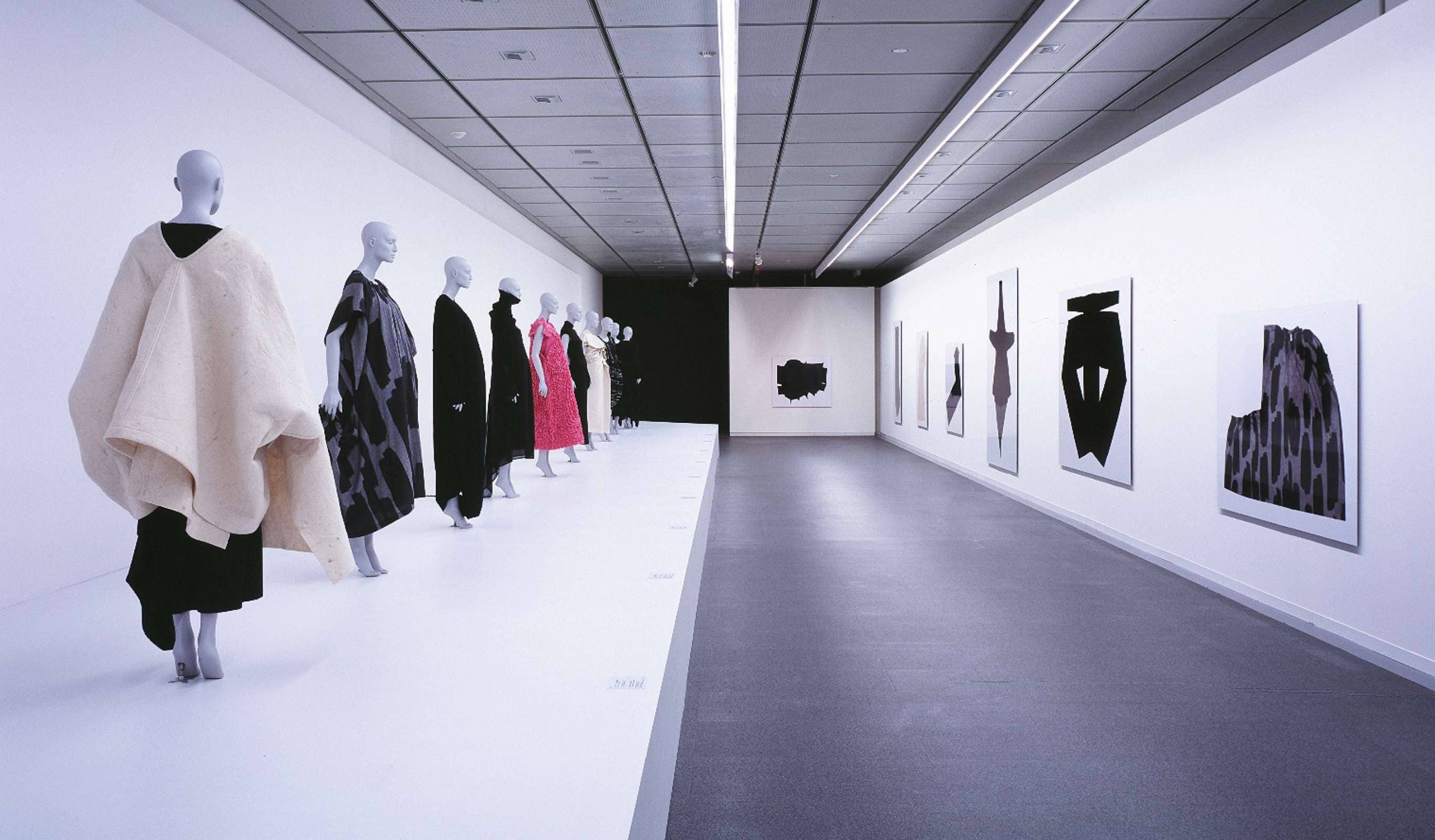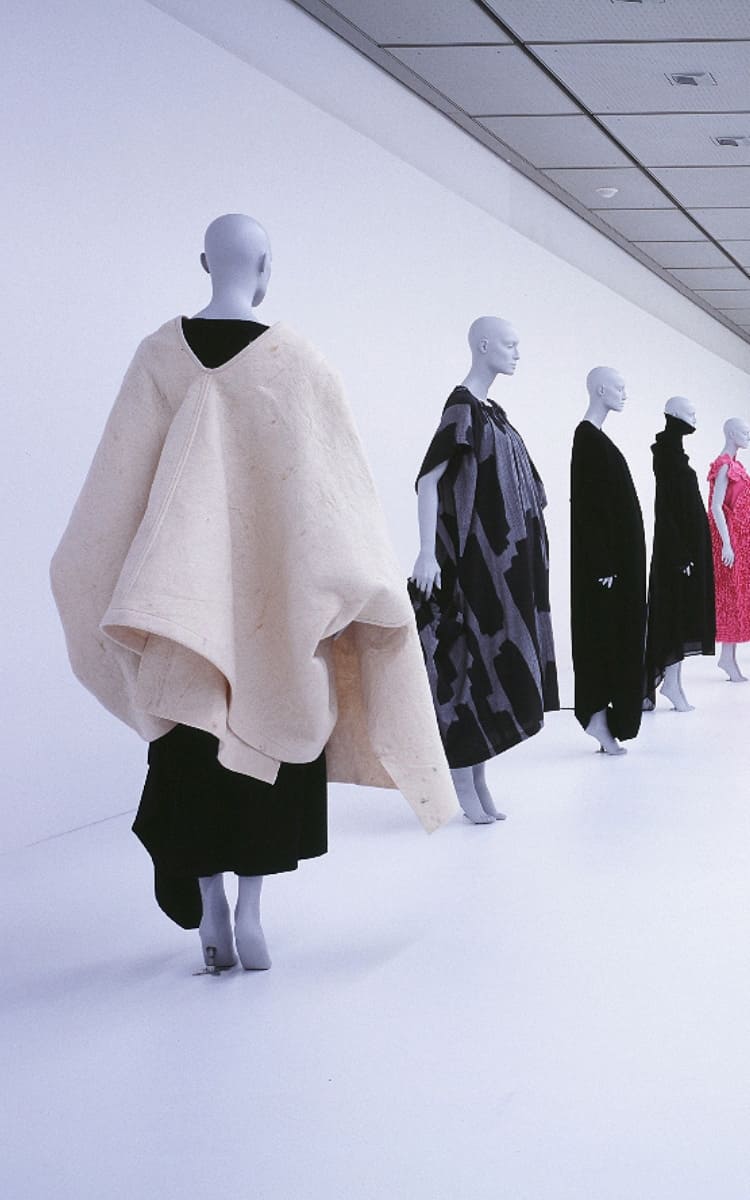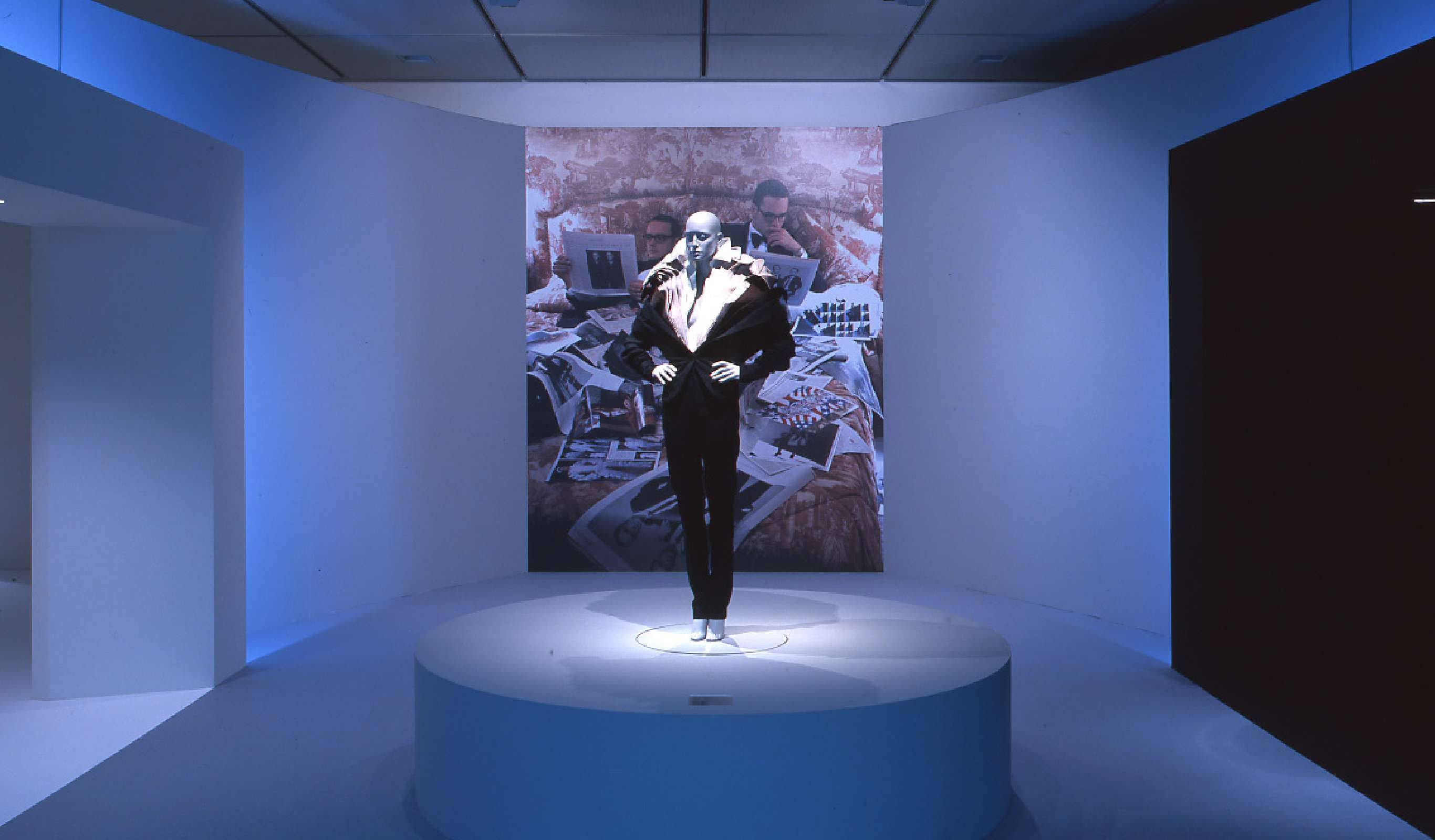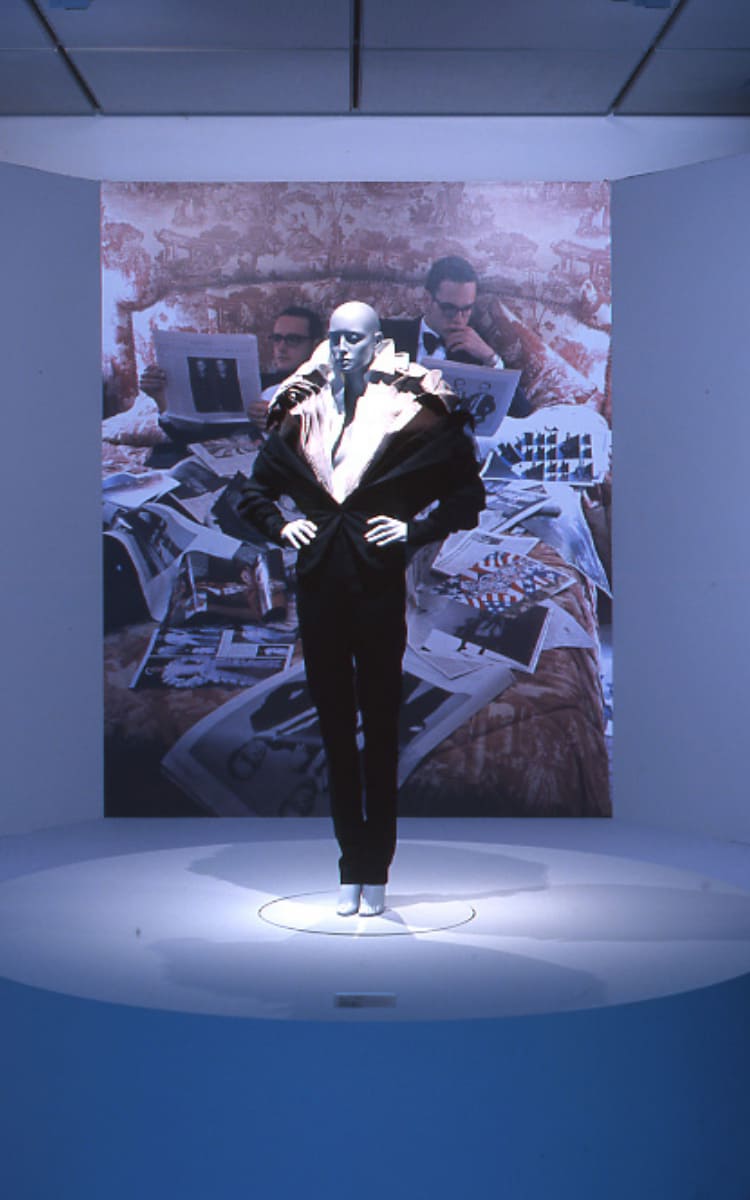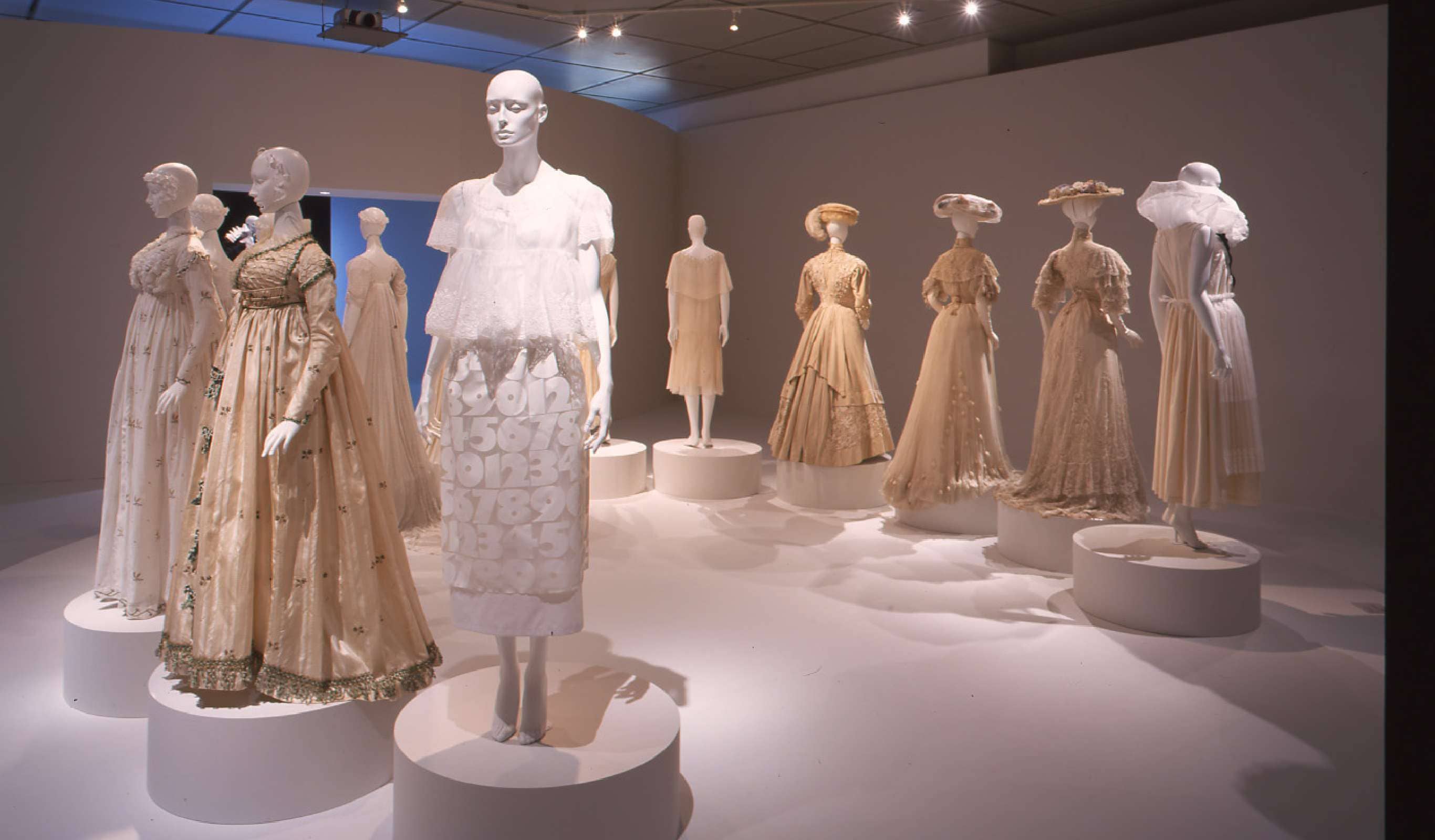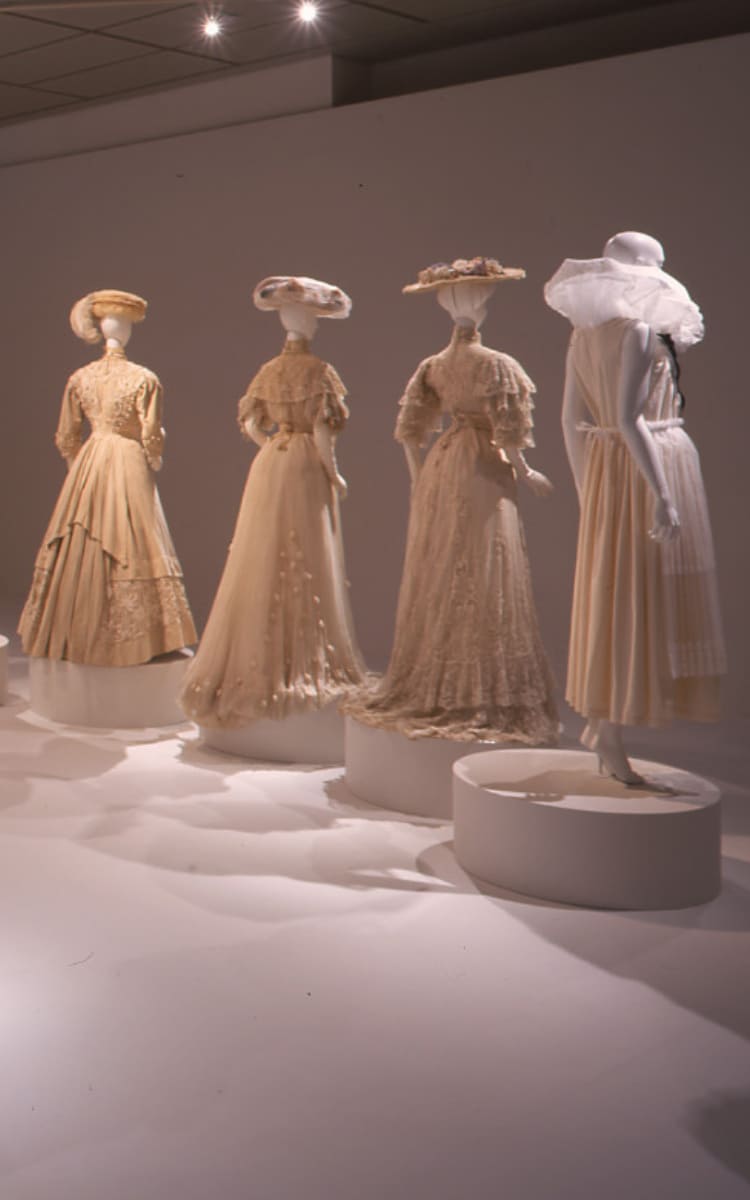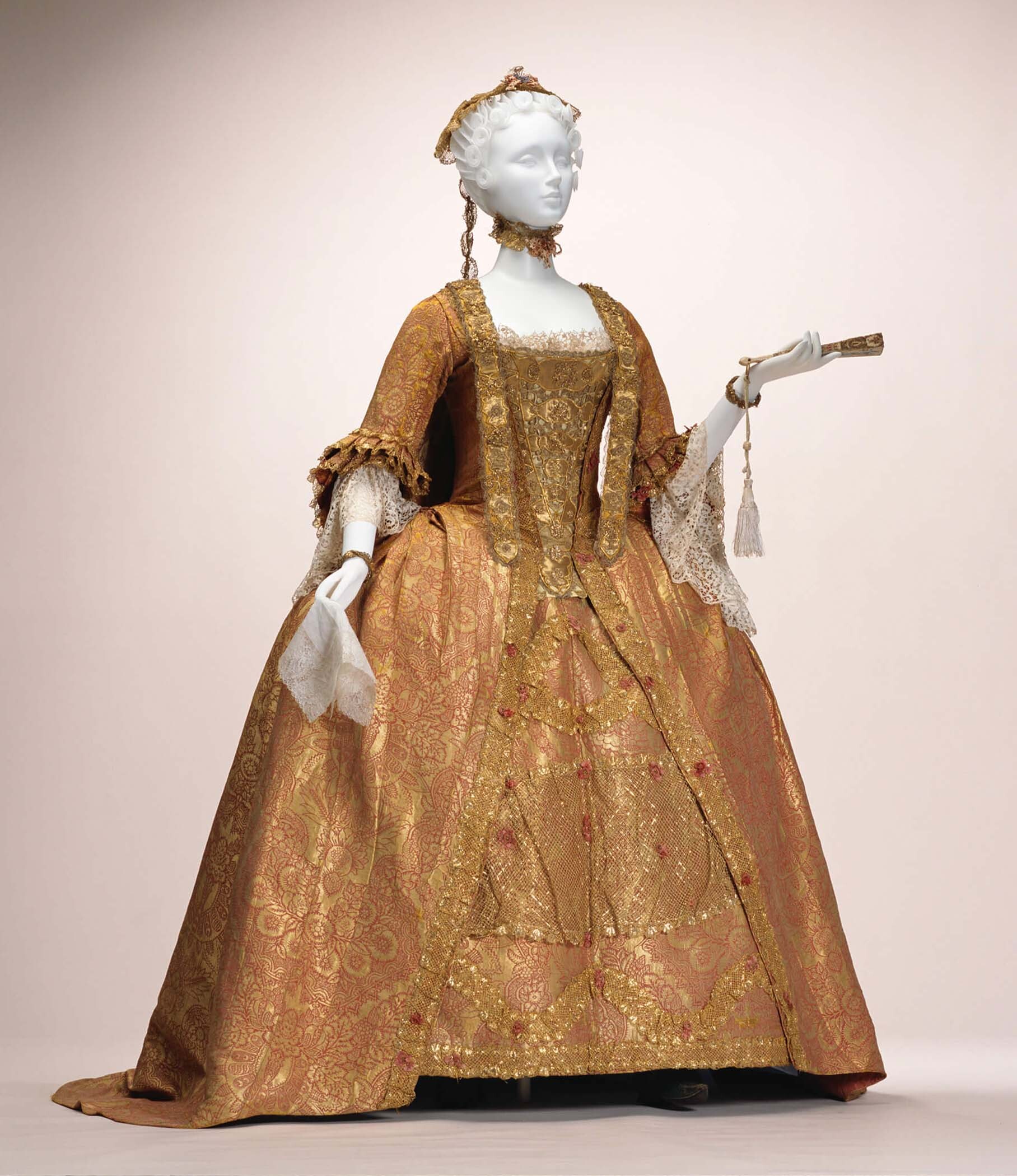 © The Kyoto Costume Institute, photo by Taishi Hirokawa
© The Kyoto Costume Institute, photo by Taishi Hirokawa
Dress (robe à la française)First half of 18th Century - Italy
Sumptuous court dress glittering with gold. The stomacher worn over the breast was the most eye-catching part of 18th Century women’s court dress. Here it is totally covered with gold lace and shining gold thread appliqué. The gown and petticoat also feature lavish use of gold thread lace (metal lace) decorations. The textile for this dress was made in Venice, which was flourishing as a production center for gorgeous silk weaving. The weft threads that produce the pattern utilize two gold threads with one yellow silk thread. The yellow silk threads become the base fabric, and the gold threads interlace with warp threads that are separate from those of the base fabric, so that the pattern is hidden on the underside. This is a complex approach requiring sophisticated techniques, attesting the luxury of this garment. The Ottoman-style patterns resemble plants such as carnations and pomegranates, symbolizing the wealth brought by trade through Venice’s role as a center for communication and commerce between east and west.
MaterialRed silk and gold threads brocade with plant motif; matching stomacher and petticoat.
Inventory Number(s)AC11203 2004-35AD
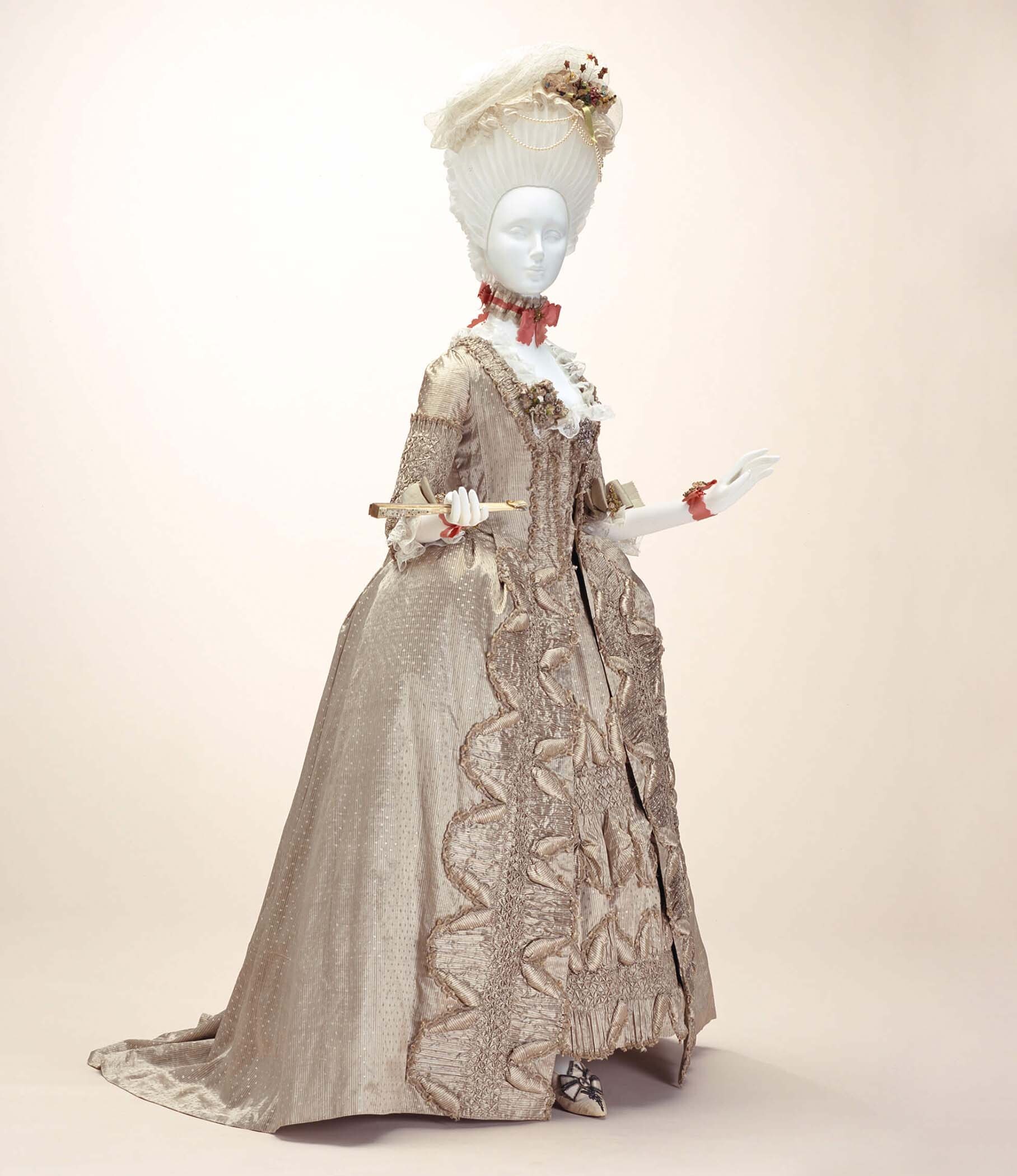 © The Kyoto Costume Institute, photo by Taishi Hirokawa
© The Kyoto Costume Institute, photo by Taishi Hirokawa
Dress (robe à la française)c. 1775
A dress that demonstrates the magnificence achievable with hand work. The subdued impression given by the elegant monochrome all the more augments the tranquil refinement of numerous ornaments created by needle and thread, along with raised decorations that ripple like the shiny luster of silk satin. Needlework ornaments made with typical French quilting techniques such as "bouillonné", where the cloth is gathered together to create bulk, "boutis", which incorporates cotton padding, and "tuyauté", where the fabric is brought into a tube-like shape, are repeated throughout the garment. These techniques may be simplistic, but they are raised to an extraordinary level of refinement in the ensemble shown here. Moreover, the delicate ornaments of chenille and fly fringes are also an expression of graceful beauty, conveying the sophistication of the Rococo France court culture.
MaterialBeige silk satin with thin stripe and dot pattern; "compères" front; matching petticoat; padded three-dimensional decoration; trimmed with fly fringe and chenille.
Inventory Number(s)AC7716 93-5AB
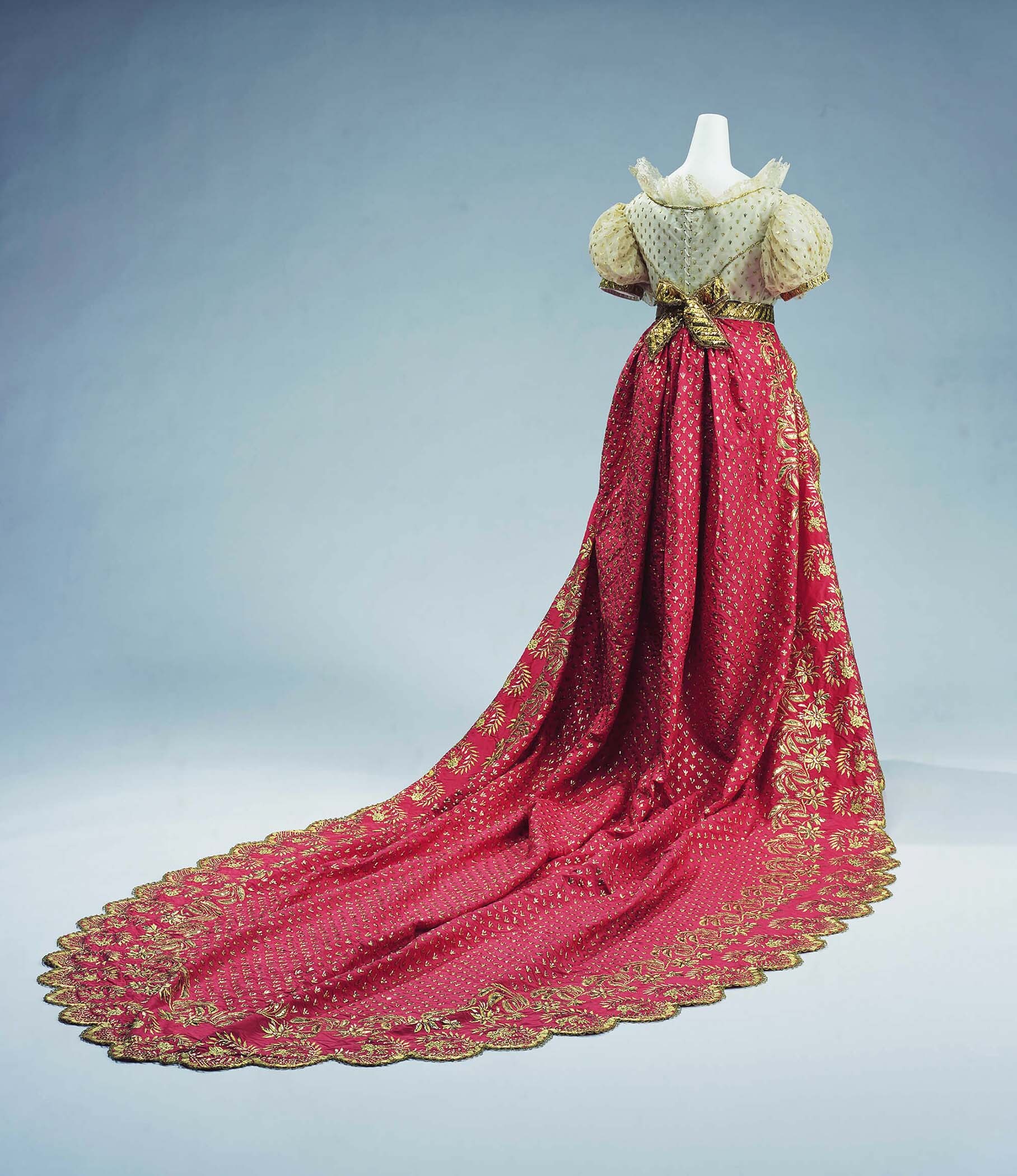 © The Kyoto Costume Institute, photo by Takashi Hatakeyama
© The Kyoto Costume Institute, photo by Takashi Hatakeyama
Court Dressc.1820 - Spain
This court dress, worn at formal occasions at the Spanish Court, conveys a sense of ceremony and solemn nobility. The dazzling gold embroidery against the red silk background of the long train is the result of incorporating gold leaf pieces in combination with gold thread to further enhance the golden glow of the fabric.
The style of women’s court wear in Western Europe had remained essentially the same since the coronation of Napoleon in 1804. Women wore decorations and jewelry reflecting one’s status, and the higher one’s status, the longer the train that was attached to the shoulder, and later, to the waist of the dress.
MaterialWhite silk satin with silk tulle embroidered with gold thread; puff sleeves; red taffeta train with gold embroidery from waist, scalloped hem.
DimensionWidth 193cm, length 280cm (train)
Inventory Number(s)AC6300 89-8AC
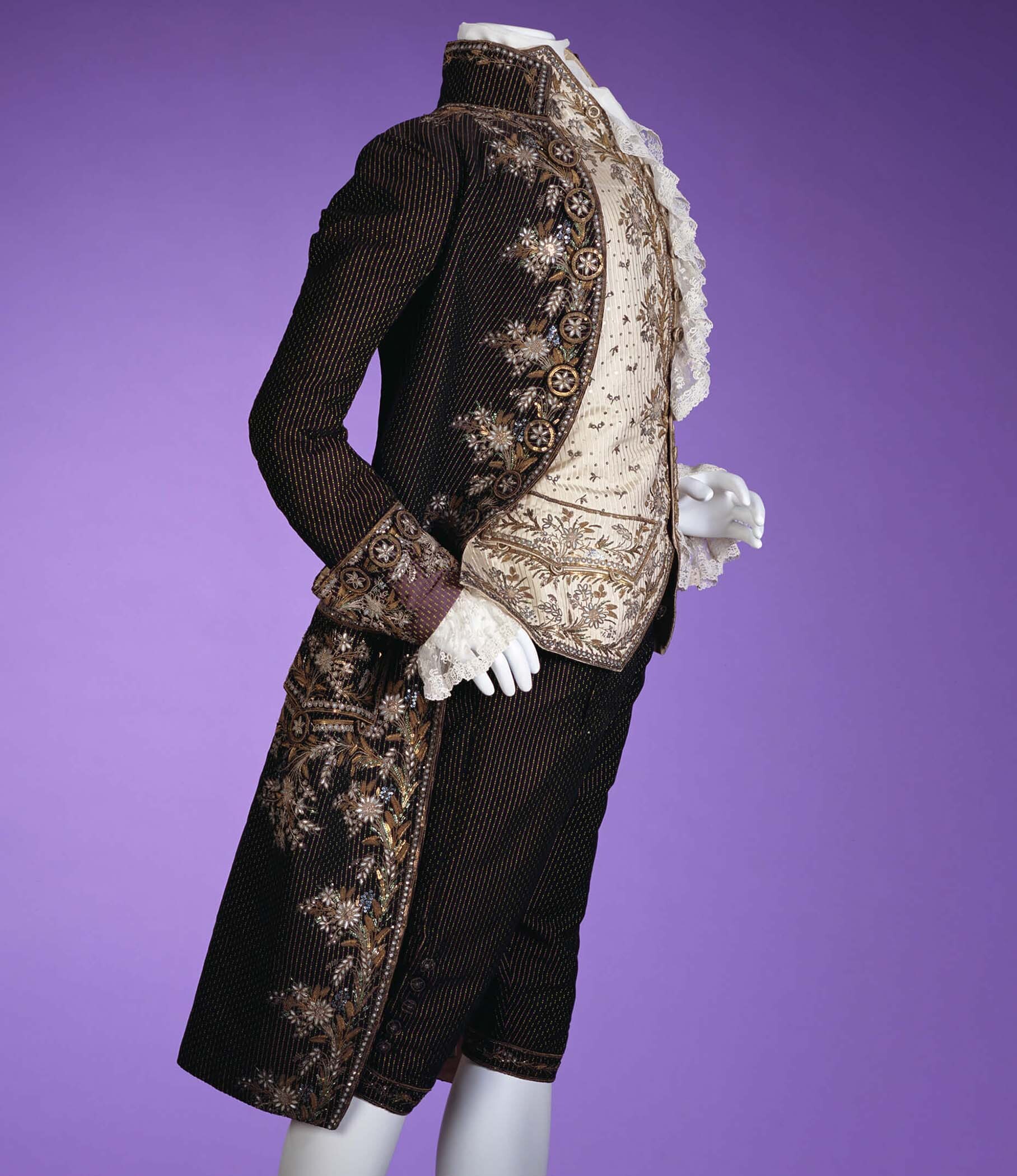 © The Kyoto Costume Institute, photo by Taishi Hirokawa
© The Kyoto Costume Institute, photo by Taishi Hirokawa
Man's Suit (habit à la française)c. 1790 - France
A narrow stripe pattern of purple and green adds lightness to this heavy-looking uncut velvet fabric. The coat and the white waistcoat are embroidered with the same floral pattern.
It may be no exaggeration to say that in the 18th century the beauty of embroidery was effectively used in men's clothes rather than women's dresses. Evidence can be found in the formal wear of Académie Française members until now. Especially the coat and the waistcoat of the panoply called "habit à la française" are fully embroidered with golden and silver threads and other multi-colored threads, sequins, and artificial gems.
At that time, there were numbers of embroiderers' workshops in Paris, whose work and workplaces were described in "L'Encyclopédie" by Denis Diderot. Men's clothes of the period were made in a way called disposition: a fabric was woven or embroidered to fit the configuration of dress fronts. It was selected according to the customer's taste, and then cut and sewn up into clothes.
Gorgeous embroideries as well as expensive laces used for jabots and cuffs, and buttons, one of the important fashionable items, were essential to finish the appearance of the chic men of the Rococo period.
MaterialThree piece set of coat, waistcoat, and breeches; coat and waistcoat of blue striped uncut velvet with sequins and glass jewels; embroidery of metallic thread, self-fabric-wrapped buttons; waistcoat of white figured silk.
Inventory Number(s)AC985 78-29-1AC
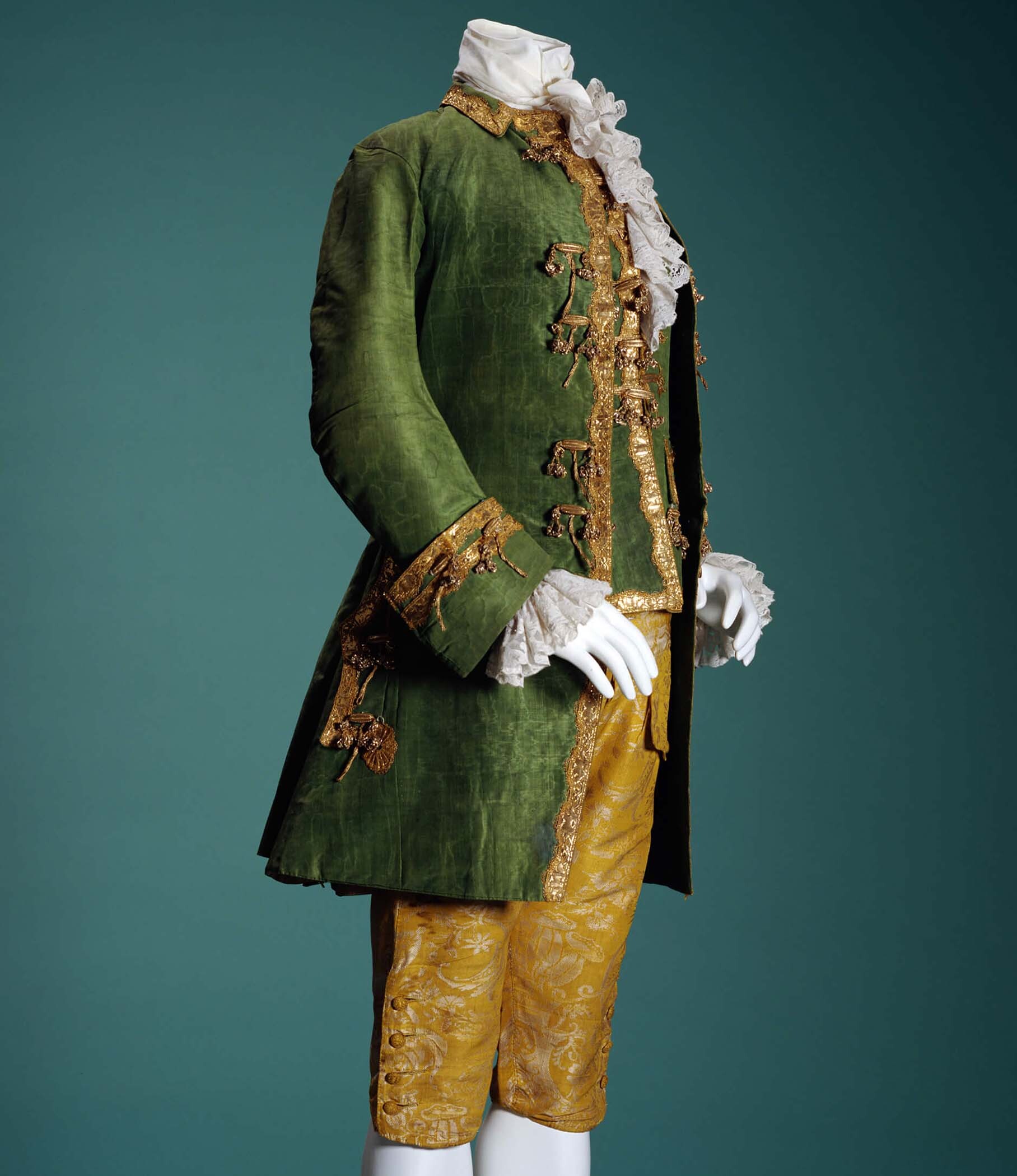 © The Kyoto Costume Institute, photo by Taishi Hirokawa
© The Kyoto Costume Institute, photo by Taishi Hirokawa
Men’s suit (Jacket, Waistcoat, Breeches)First half of 18th Century - Italy
Sumptuous eighteenth-century men’s suit. The glossy moiré effect that stands out from the green textile is produced using a horizontally-ribbed material called “gros-de-Tours” by folding the material repeatedly and passing it through a calender under pressure. The resulting textile gained a reputation of being indisputably beautiful. Gold thread is used lavishly for the braid trimmings and frog fastenings. In addition to its rarity value, gold is highly resistant to oxidation, retaining its gleam almost indefinitely. Since ancient times, these properties have made it a valuable tool for flaunting the power and wealth of the wearer. Gold thread also has a long history, and is mentioned in the Old Testament of the Bible, written long before the start of the Christian era. Gold thread takes many forms, but this particular garment includes gold flat strips and gold strips wound around yellow silk thread. The fabric used for the breeches has “bizarre” patterning. Such woven patterns were popular in England, France, and Italy around the end of the 17th Century and beginning of the 18th Century. They use asymmetric arrangements of combinations of plant patterns with elements having an oriental flavor.
MaterialJacket and waistcoat of green silk gros-de-Tours moiré; trimmed with braids and tasseled frog of gold thread; breeches of yellow and white silk brocade with floral motif.
Inventory Number(s)AC11336 2005-15-1AD, AC11337 2005-15-2
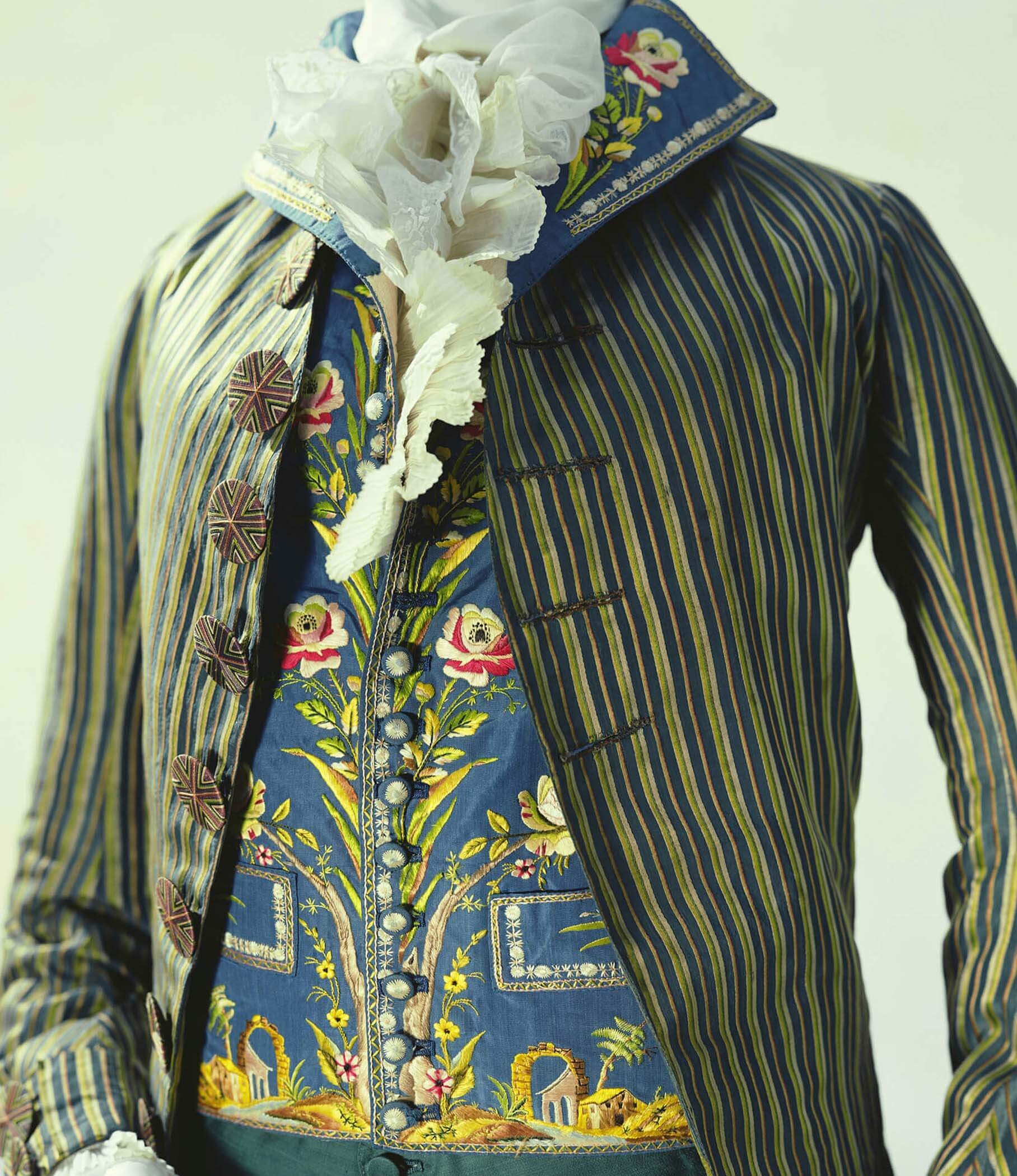 © The Kyoto Costume Institute, photo by Toru Kogure
© The Kyoto Costume Institute, photo by Toru Kogure
Man's Suit (coat, waistcoat, and breeches)c. 1790 - France
On this waistcoat are delicately embroidered arches and rows of pillars in the style of ancient Rome. During the latter half of the 18th century, under the influence of neoclassicism, ancient Roman and Gothic ruins and remains were frequently adopted as motifs in paintings, garden fixtures, and such.
At the end of the 1780s, just before the French Revolution, coats and figures that were decorated by spectacular embroidery disappeared, while striped patterns came into fashion. Waistcoats had a lapelled collar and their length became extremely short. From the end of the 1780s to the first half of the 1800s, while coats were being simplified, waistcoats were adopting the showier tendencies of men's fashion.
MaterialCoat of blue and green striped silk taffeta and satin; fold-back standing collar; cut-away from hem; waistcoat of silk faille with Roman-like arch embroidered showing a country scene; wing collar.
Inventory Number(s)AC5146 85-28-2AC, AC5667 87-35-1

